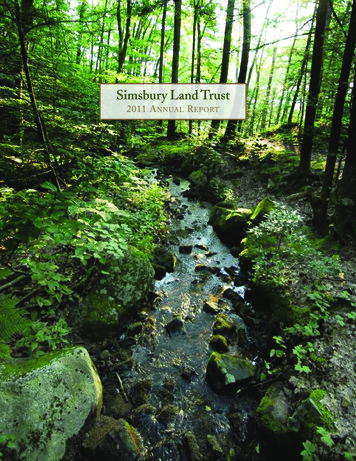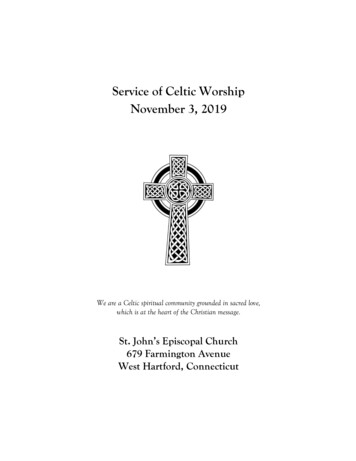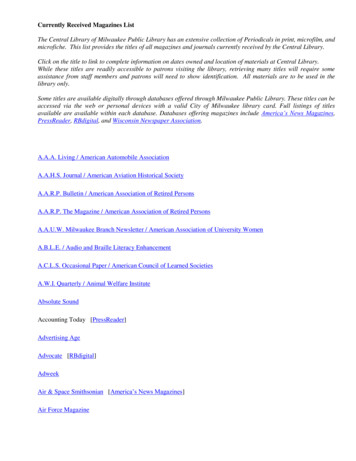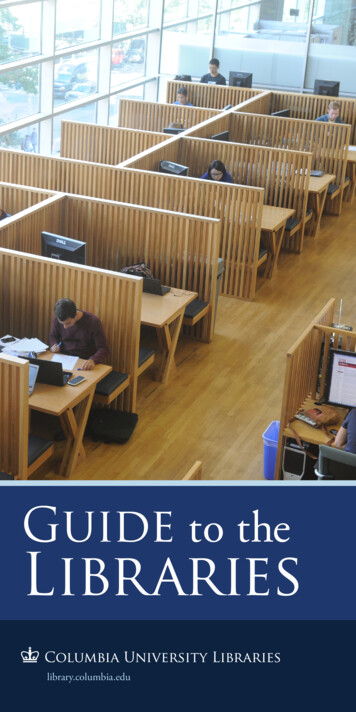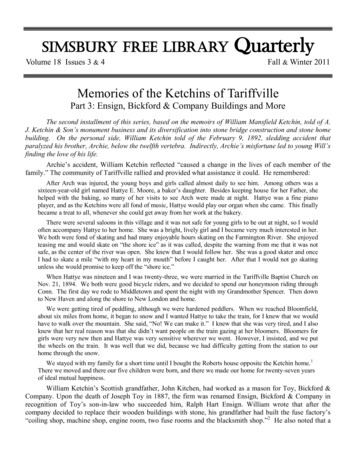
Transcription
Simsbury Free LibraryVolume 18 Issues 3 & 4QuarterlyFall & Winter 2011Memories of the Ketchins of TariffvillePart 3: Ensign, Bickford & Company Buildings and MoreThe second installment of this series, based on the memoirs of William Mansfield Ketchin, told of A.J. Ketchin & Son’s monument business and its diversification into stone bridge construction and stone homebuilding. On the personal side, William Ketchin told of the February 9, 1892, sledding accident thatparalyzed his brother, Archie, below the twelfth vertebra. Indirectly, Archie’s misfortune led to young Will’sfinding the love of his life.Archie’s accident, William Ketchin reflected “caused a change in the lives of each member of thefamily.” The community of Tariffville rallied and provided what assistance it could. He remembered:After Arch was injured, the young boys and girls called almost daily to see him. Among others was asixteen-year-old girl named Hattye E. Moore, a baker’s daughter. Besides keeping house for her Father, shehelped with the baking, so many of her visits to see Arch were made at night. Hattye was a fine pianoplayer, and as the Ketchins were all fond of music, Hattye would play our organ when she came. This finallybecame a treat to all, whenever she could get away from her work at the bakery.There were several saloons in this village and it was not safe for young girls to be out at night, so I wouldoften accompany Hattye to her home. She was a bright, lively girl and I became very much interested in her.We both were fond of skating and had many enjoyable hours skating on the Farmington River. She enjoyedteasing me and would skate on “the shore ice” as it was called, despite the warning from me that it was notsafe, as the center of the river was open. She knew that I would follow her. She was a good skater and onceI had to skate a mile “with my heart in my mouth” before I caught her. After that I would not go skatingunless she would promise to keep off the “shore ice.”When Hattye was nineteen and I was twenty-three, we were married in the Tariffville Baptist Church onNov. 21, 1894. We both were good bicycle riders, and we decided to spend our honeymoon riding throughConn. The first day we rode to Middletown and spent the night with my Grandmother Spencer. Then downto New Haven and along the shore to New London and home.We were getting tired of peddling, although we were hardened peddlers. When we reached Bloomfield,about six miles from home, it began to snow and I wanted Hattye to take the train, for I knew that we wouldhave to walk over the mountain. She said, “No! We can make it.” I knew that she was very tired, and I alsoknew that her real reason was that she didn’t want people on the train gazing at her bloomers. Bloomers forgirls were very new then and Hattye was very sensitive wherever we went. However, I insisted, and we putthe wheels on the train. It was well that we did, because we had difficulty getting from the station to ourhome through the snow.We stayed with my family for a short time until I bought the Roberts house opposite the Ketchin home.1There we moved and there our five children were born, and there we made our home for twenty-seven yearsof ideal mutual happiness.William Ketchin’s Scottish grandfather, John Kitchen, had worked as a mason for Toy, Bickford &Company. Upon the death of Joseph Toy in 1887, the firm was renamed Ensign, Bickford & Company inrecognition of Toy’s son-in-law who succeeded him, Ralph Hart Ensign. William wrote that after thecompany decided to replace their wooden buildings with stone, his grandfather had built the fuse factory’s“coiling shop, machine shop, engine room, two fuse rooms and the blacksmith shop.”2 He also noted that a
2Simsbury Free Library Quarterly“John Kitchen Mason Tariffville Ct.” is the heading for William Ketchin’s grandfather’saccount in the 1851-1862 Toy-Bickford & Company ledger, shown in part above. The account, onpage 473, lists the debits and credits running from March to September 1860. The accountcontinues on page 528 through December 1860. The company paid John Ketchin a total of 2,325.78 that year, about 55,753 in today’s dollars. Born in Paisley, Scotland, and brought tothis country as a child, he was forty-three in 1860.horse was a luxury that his grandfather could never afford; he walked from Tariffville to the fuse factory,four miles each way.John Kitchen retired from his masonry business about 1889 because of crippling rheumatism.William’s father, Andrew J. Ketchin, stepped into his place, while still making cemetery monuments inTariffville. “More and more stone building was taken on until the monumental business was crowded outand the ‘Marble Shop’ sold,” William wrote. The first major building that A. J. Ketchin built for Ensign,Bickford & Company was the cotton mill. He was just about finished with his apprenticeship, Williamrecalled, dating the construction of cotton mill about 1888. For that building, William wrote that he “cut thecorners and caps and sills of the windows and jambs of doors and windows.”He wrote that from the time that Ensign, Bickford & Company took over the Climax Fuse Companyin Avon, Connecticut, until 1925, A. J. Ketchin & Son built all the stone buildings for the company, both inAvon and Simsbury.3 As William recalled,Our firm tore down wooden buildings and rebuilt of stone. The little old brick office [in Simsbury] wastorn down and the present stone office built instead. The stone for the new office [was] quarried from aboulder found in the pasture lot of Aaron Eno. His boulder came out with smooth beds and in thickness from3 inches to 8 inches, requiring no cutting. It was grayish red and very hard and the seam beds were assmooth as if cut. The architect for the office building was delighted with it, but we were afraid that it wouldnot produce enough of the fine color and smooth beds to complete the building. We finally chanced it and itproduced JUST enough and NO MORE. The entire construction was erected from that boulder. Caps, sills,window jambs came from the quarries of A. J. Ketchin & Son at Tariffville and Avon. The entire boulderwas consumed in that building, at least that part of it that produced the smooth beds. I personally had thepleasure of cutting the date shields and date of the Ensign Bickford office.4He says in a different section of his memoirs that they “opened a quarry from a brownstone outcropon the property of Aaron Eno in Simsbury,” apparently in addition to the boulder. He mentions that thestone for the Ensign, Bickford & Company cotton mill was quarried “in the pasture at the rear of AaronEno’s house.”5 He wrote, “Father could almost smell the size of a boulder about our part of the state, even ifit only stuck out of the ground a couple of feet.” He also wrote, “Later we got considerable stone from a holeadjacent to the Wilcox place on ‘Goose Hill.”
Simsbury Free Library Quarterly3As their construction business prospered, the Ketchins added their two largest quarries:Finally, we located an outcrop about a mile from Tariffville on the Terry’s Plain Road and purchased athree-acre spot from Chancy Eno and from there we quarried all the stone for the Ensign-Bickford buildingsat Simsbury, except for the office building.6For the E-B & Co. buildings at Avon, Conn., we bought a ten-acre lot on the side of the Talcott Mountainwhere we had located a boulder outcrop, which was about one and a half mile from the works. By soundingswe found that the rock extended over a sufficient territory for our purpose. The stone was a lively brown andsome softer than our Tariffville stone.7 On the Joseph Ensign home at Simsbury, all corners, jambs, windowcaps and mouldings were quarried at Avon and brought to Simsbury as that stone was easier to cut than thatat [our] Tariffville quarry.8In quarrying stone for the Ensign [Bickford] buildings at Simsbury and Avon, we had to quarry blockslarge enough to make caps and sills for windows and doors. These had to be 6'0" x 1'0" x 6 inches for capsand sills and [for] corners had to finish 12" x 18"x 6" at least; so we had to be careful in blasting that thecharge did not shatter the block or blow the stone out in small pieces. This could not be controlled withdynamite, so we used powder. We would usually run a 2-inch hole down 4 to 6 feet and put in a smallcharge to open up the seams, then put in a second charge that would work out through the seams and loosensome pieces large enough for out purpose.On February 2, 1893, an article in the Harford Courant said, “Ensign, Bickford & Co. have nearlyfinished rebuilding their shops damaged by the powder explosion and expect to run full time about March 1.”William Ketchin wrote:The Ensign-Bickford Co. had an explosion at Simsbury which demolished several stone “fuse rooms” andA. J. K. & Son were called to rebuild them. That winter was very severe and cement would freeze as soon asit struck the wall. Finally, all cement mortar was mixed with water from barrels in which was kept a bag ofcattle salt. All through Feb. the thermometer stayed near zero. Masons and tenders wore heavy clothing, feltboots and heavy gloves, but the cement mixed with “brine” enabled the men to lay up the walls.Up to the floor line of these fuse rooms, the walls were 24 inches thick; above the floor line they were 18inches thick. The stones would vary from 5 lbs. to 150 lbs. and were simply fitted in place, not cut, buthammer dressed. Four years after these buildings were built, some changes were made where 1½-inch pipeswere put through the 24-inch walls below the floor. The Co. sent [for] me, who was building some otherbuildings for the Co., and asked me to send someone over to the fuse rooms to drill some holes for theplumber. Remember these walls were made of small and large stones and the cement was mixed with saltwater. The 2-inch holes were drilled through the wall without disturbing the surrounding stones, showingthat the mortar in which they were laid was as hard as stone. With the above experience in mind, when yearslater I established a Cement Products Plant in Florida making blocks, brick, pipe, etc., I used sea sand tomake harder, better products than could be made with the local or bank sand.William Ketchin described his firm’s business arrangement with Ensign, Bickford & Company inthis way:In the early days, A. J. Ketchin & Son furnished E. B. & Co. their outside labor, such as unloading juteThe Simsbury Land Trust owns and maintainsthe Ketchin Quarry on the east side of QuarryRoad. The Trust has placed explanatory signsalong the short walk it has laid out.These photos were taken last December during a walkwith Trustee Sally Rieger.
4Simsbury Free Library Quarterlyand coal cars, concrete walks, and any other outside-of-shop labor. The factory buildings and office werebuilt under contract, while most of the outside-of-shop labor was cost plus 10%.In building the E. B. & Co. buildings, A. J. K. & Son furnished the stone and built the walls, while thecompany carpenter handled the woodwork. The contract on this work was so much pr. Perch (16½ cu. Ft.)measured in the wall. The foundations, as to width and depth, were left to the judgment of A. J. K. & Son,so they were particular to get a firm bottom. Some foundations buried many perch of stone below groundbefore a “hard pan” bottom was reached, but the company backed the judgment of A. J. K. & Son, on everybuilding but one, “the old shipping room,” where two soft spots were encountered and the Co. insisted thatlarge flat stones be used instead of going to hard pan.Several factors contributed to the initial success of their stone construction business and to problemsthey later encountered. William wrote:I took a home study course in architecture with the I.C.S. [International Correspondence School]. Thishelped the construction firm, and, with the sound Scotch judgment at A. J. Ketchin, the firm was successful.The office was at Tariffville and we kept our operations within 10 miles of the office. Most of the work wasstone buildings, although all kinds of work were handled.In those days (1896-1925) or the fore part of that period, the labor unions were not strong, and as A. J. K.& Son were twelve miles from Hartford and the firm took no contracts outside a ten mile radius fromTariffville. The quarries were also within that radius. This advantage enabled the firm to underbid anyoutside contractors bidding on work within the Simsbury area (any stone work).The first stone building that the firm built (stone walls only) was the Walter Phelps Dodge residence atBushy Hill, Simsbury.9 Chas. A. Ensign of Tariffville had the general contract and the stone walls weresublet to A. J. Ketchin & Son. Some of the masons were hired locally and some came from Hartford. Mostof the Hartford masons were union men, but as A. J. K. & Son paid union wages and their masons lost notime waiting for building materials, as was the case in city construction, masons soon learned that moremoney was made working for A. J. K. & Son in the country, dropped their union dues and acquired homes inSimsbury. This arrangement did not help to support a union “walking delegate” so they (the union) watchedfor a chance to “jump” A. J. K. & Son.An article in the Hartford Courant on January 9, 1906, announced, “A. J. Ketchin & Son havefinished the stone work on J. R. Ensign’s new house. Robert Porteus of Hartford has the contract for thecarpenter work.” William gave this account of the job:When the firm started the Joseph R. Ensign residence in Simsbury, a fine stone building (stone from A. J.K. & Son quarry), on which they had the contract for furnishing, cutting and laying the walls, the unionthought they saw their chance to “jump.” All window sills, caps, and jambs were cut stone. Windows werecapped by “flat arches” and door jambs moulded. Nine stone cutters were employed. Of the nine, only one,a Scotchman from New Haven could follow a pattern for door mouldings. One of the nine, a union manfrom Hartford, was not even able to cut the flat arches over the windows and finish with a “filling” key. This“bird” reported to the union that Brown of New Haven was on the job and was “unfair” with the union.One day Kelley of Kelley Bros. of Hartford (brownstone sawyers), who was the “walking delegate” of theunion, appeared on the job. Coming to me, he said, “You have a cutter here who is unfair with the union,and you must let him go, or all the other union cutters will strike.” He said the man was Brown of NewHaven and he owed the union eight-five dollars. As Brown was the only cutter on the job who could cutmouldings, I said, “Let me talk with Brown.”Brown had a young family, and at Christmas time he had been out of work so much that it looked like agloomy Christmas. He took a job “on his own” to build a house cellar, which enabled him to have “a bit of aChristmas” for his three kiddies, and because he did not first go to the union and pay them twenty-fivedollars for a contractor’s permit, the union fined him eight-five dollars. He could not pay it, so was droppedand listed “unfair.”
Simsbury Free Library Quarterly5I told Kelley that I thought under the circumstances the fine was high. I argued that it was November andvery little cutting was going on. Furthermore, the owner would not care if the work was shut down untilspring. But Kelly was adamant. Brown wanted to quit to save the other cutters, but I asked him to waitdevelopments.Kelly had to wait three hours for his train back to Hartford. This gave me a chance to think. A. J. K. &Son had another contract on the Wilcox residence in Simsbury.10 In this contract was a large pergola. [The]pergola floor, steps, and columns were to be of sawed brownstone. There were also two large chimney capsof sawed brownstone. The furnishing of the sawed stone on the job amounted to twenty-five hundreddollars. I knew that this job was ideal for Kelley Bros., so while Kelley was out to lunch, I spread theWilcox plans out on this table, being careful to have the sawed brownstone plans in sightKelley came around to talk and became very much interested in the Wilcox plans showing the sawedbrownstone. He asked me if I had the job, saying that he (Kelley Bros.) had just installed a new saw and thatkind of sawing was right up his alley, and he asked if he could figure the job. I told him that he could, but allthe copies were out and I could not spare those. However, if he would promise to have them back the nextThe shield (left) is one of the pair that William Mansfield Ketchincarved to place on either side of the main door of Ensign, Bickford &Company’s Simsbury office (below). The shields bear the dates 1836and 1896, the year that the company was founded and the year that theoffice was built. William Ketchin wrote in his memoirs that A. J.Ketchin & Son tore down an earlier small brick office and replaced itwith this stone two-story building, constructed from a single boulder.Photograph and postcard courtesy of the Simsbury Historical Society
6Simsbury Free Library Quarterlyday, he might take them. So when Kelley took the train to Hartford, he had the plans.I boarded the train with a plan in my head. Walking through the cars I came on Kelley with the plansalready spread before him. I stopped and made a few remarks, passed on and came back in fifteen or twentyminutes. I stopped and said, “Do you realize, Kelley, that trouble on the Ensign house with Brown is goingto knock nine men out of employment? Because as soon as the owner knows about it, he will shut the jobdown until spring. It would be cheaper for him anyway, as the job is cost plus. I believe we could straightenout that Brown trouble if you would call a union meeting and arrange to have that unjust fine of eighty-fivedollars cancelled if Brown will pay up his regular dues. There is no other stone cutting going on now, andthat would give the men another month’s work before we shut down for the winter. If you will call ameeting of the union, I will arrange to send the nine men on my job to attend. I am sure you could arrange towipe that fine off the books as easily as it was put on.” Kelley called the meeting and the fine was cancelled,but the sawing of the brownstone for the Wilcox job went to the Bell Co. of Portland, Conn.Elsewhere in his memoirs, William wrote that they had been hired to build the stone addition on the northside and the porte-cochere on the south side of the Wilcox house. They used brownstone from the quarry inPortland because it was much softer and more easily worked than the stone in the Ketchin quarries.The problems between the Ketchins and the stonecutters’ union continued.remembered,William KetchinThe next time the union jumped A. J. K. & Son was at the Westminster School job, where I had designedthe Gym., Swimming Pool, servants’ quarters and some of the Dormitories. But before telling of that uniontrouble, the difference between the Portland, Conn., brownstone and that of the A. J. K. & Son quarries ofSimsbury, Conn., and some of the union rules, must be explained.As stated, A. J. K. & Son established quarries at Tariffville and Avon, Conn. These quarries wereoutcrops of brownstone, not soft, however, like the brownstone at Portland, Conn., which could be easily cutby using a wooden mallet and headed steel tools. But the Ketchin stone was so hard that it could be cut onlyby using granite tools. Furthermore, the union had established two stonecutters’ unions, the soft stone cutterswere distinct from the hard stone cutters. The soft stone cutters of Conn. worked with mallet and headedtools, while the granite or hard stone cutters of Vermont worked with steel hammers.Rather than send for cutters from the granite quarries, A. J. K. & Son had for several years furnishedgranite tools for the Conn. men. The cutters were paid soft stone union wages, although A. J. K. & Son didnot recognize any union. Under union rules, sixty day’s notice must be sent to contractors of anycontemplated changes in the scale of wages. This was to protect contractors in figuring work.After the Westminster work was well started, the soft stone cutters’ union notified us that their cuttersshould be paid 10 pr. hour more; that they had notified the firm of the raise sixty days before the workstarted. The firm replied that no notice had been received. Of course, we knew that the union was trying tomake their threat good to “put the Ketchins out of business.”The firm at that time was paying the soft stone cutters 10 pr. hour more than the hard stone cutters weregetting in Mass. and Vermont and furnishing them with hard stone tools beside. We then invited thePresident and Secretary of the soft stone cutters’ union to come to Simsbury and look the job over beforedeclaring us “unfair.” This they agreed to do; so, on the appointed day, I put a “maul” (wooden mallet) and a“drove” (wide steel chisel used in cutting soft brownstone) into my car, and met the officers of the soft stoneunion, and drove to the quarry at Tariffville. There I handed [the President] the wooden maul and drove andasked [him] to note how easily our brownstone worked with soft stone tools.With the first blow, the drove bounced off the stone as if it had been a block of steel. The Presidentlooked astonished and asked if all our stone was as hard. Of course he was told that the firm had furnishedgranite tools to the cutters, because they were Conn. men. But to save further trouble with the soft stonecutters, we had hired granite cutters from Mass. and Vermont to take the place of the soft stone cutters, whoreally had no business doing the work. The Pres. and Sec’y then proposed that the Conn. men be kept on at
Simsbury Free Library Quarterly7the old wage until the job was done, but were told that it was too late. The soft stone union let us alone afterthat.William Ketchin wrote that in his Grandfather John’s day “a mason journeyman was supposed to beskilled in laying stone, brick or plastering.” While building for the Westminster School, A. J. Ketchin & Sondid some stuccoing. He wrote,We designed and built the Gym. and Swimming Pool at Westminster School that were built of a hard,shelly stone found in the Tariffville quarry. When that particular vein of stone came out, it was hard asgranite. But when exposed to the air and frost, it began to break up, so we dared not use it on any exposedwall. We had to get rid of that stone or that vein, and, in figuring the Westminster Gym. and Pool, wefigured it could be used to advantage by laying it up rough (not hammer dressed as usual) and stuccoing bothsides with Portland cement. This we did, saving the School considerable and giving them a permanent job. 11William mentioned that although they constructed the gymnasium and swimming pool of stone and cement,the servants’ quarters were built of wood. The company did very few wooden structures, but had the abilityto build them. Also, while doing work for the Village Water Company, their company “laid the water pipeup to Simsbury Street [probably the present Hopmeadow Street] and through the street to WestminsterSchool.” William and Hattye’s son, William Andrew Ketchin, later graduated from the school.Returning to the construction company’s work for Ensign, Bickford & Company, William recalledthat his men used to eat lunch at the boarding house that was near the company’s Simsbury factory. The1900 Federal census shows a boarding house run by James Welton, 71, and his wife, Laura, 67. They livedin the house along with a servant and twenty-three boarders. The boarders were women and men of variousages and they were a mix of native-born and foreign-born people. Most worked at the fuse works, but onewas a brakeman for the railroad, one was a patent medicine dealer, two were “musical artists,” and threewere stone masons.William told this story having to do with meals at the boarding house and the meatless Fridaysobserved by his Catholic workmen. He titled the story Pat and the Fish Dinner.Whenever we were building at the Ensign-Bickford plant at Simsbury, we were close to the Weltonboarding house, so most of us arranged to have a hot luncheon. A long table was set aside for our men. OneFriday as about twenty of us sat down, the waitress came in, and quickly passing from one to another, shewould lean down and quietly say, “Meat or fish?” As the waitress came to the man next to Pat, the man said“meat” and as she came to Pat he simply nodded his head. When the dinner came in, Pat’s plate was heapedwith meat. He looked at it an instant, then crossing himself said, “God knows twa fish I asked for.”However , the mistake did not dampen his appetite.He had several more lunchtime stories. This one he called Adventures of John Hill.John was an Irish stone mason who had worked for my Grandfather, so we kept him on the payroll. Ourwork was scattered and most of the time not near any place where we could get a hot lunch, so we all carriedlunches in a “Dinner pail.” This pail was a tall thin pail. Coffee was carried on the bottom, there was amiddle section for bread and the meat, and a top tray for pie and on the top cover, a tin cup.The day in question, we all placed our pails on the ground under an apple tree near our work. At noon weall gathered under the shade of the tree to eat our lunch. Everybody let out a wild yell as he took the coverfrom his pail, for small red ants had taken possession. There was nothing to do but carefully scrape the antsoff and retrieve as much of the lunch as possible.While everybody was busy doing this, I noticed that John Hill was busily eating. I looked at his breadand sure enough, it was covered with ants. I said, “John, look at your bread. It is covered with ants.”Without batting an eye, John kept right on eating and said, “It’s a dam sight worse for them than it is forme.”
8Simsbury Free Library QuarterlyWilliam wasn’t above telling tales of his own misadventures. For example, seeing that the companyneeded only a part of their ten-acre lot on Talcott Mountain for their Avon quarry, he pondered how to usethe rest of the land.It was said that apples were better if grown on the mountainside, and we needed but a small portion of thelot for quarry purposes. I thought to set out an apple orchard. This thought crystallized when I found an old,neglected apple tree on the place with some most excellent “sheep nose” apples on it. So I purchased and setout 100 apple trees.They grew well and when they had been set a year they were sturdy trees, one inch or more in diameter.That winter snow came to a depth [of] 18 inches, followed by a cold rain, which froze and covered the snowwith a heavy crust. This prevented rats, mice and rabbits from burrowing under the snow for food. So theystood on the snow crust and “girdled” my young trees . about a foot from the ground. They had eaten thebark as far up as they could reach, completely around, thus killing every one of them. If I had consultedsome old apple grower, he would have told me to wrap my young trees with building paper to the height of 3feet to protect the tender bark.The following incident also took place in Avon. William called this story A Quarry Upset.This upset occurred at the Avon quarry after we had uncovered a considerable table of nice brownstone.This stone was much easier to work than the quarry at Tariffville. We erected a “shack” about 12' x 20' andbuilt rough bunks so that 8 or 10 of our men could stay there through the week instead of driving each dayfrom Tariffville (10 miles). We put in an old cook stove, a sink and a few simple utensils. A fine spring onthe lot furnished good water. A rough board table and empty powder kegs for chairs completed thefurnishings. The powder kegs [were] wood barrels about 12 inches in diameter and 16 inches high with a 2inch bung hole in one end. They held 25 lbs of blasting powder and came to us from E.B. & Co.For safety, when they came to us, we immediately emptied them to a tight-stoppered copper container andfilled the barrel with water for 24 hours, after which the barrel became a chair.One night the 8 men were seated on the empty powder kegs around the table smoking and playing cards.The foreman, Wm Sacolasky, lighted his pipe and, as he had often done before (for safety), dropped the burntmatch through the bung hole of the keg on which he was sitting. Instantly there was a loud explosion andmen, table and cards were lifted to the ceiling. No bones were broken or serious cuts, but plenty of scratchesand bruises. They all claimed that every keg had been properly watered and soaked. But thereafter all kegbung holes were “plugged” after emptying.Apparently, A. J. Ketchin & Son never had a workman killed on a job. The most serious accidentWilliam reported was in this story titled Tariffville Quarry and Joe Boras.Joe Boras was Polish, a strong, well-built chap of 25-30, and, after working for us a short time, he becamea “handyman.” When occasion required, he was sent to help out at the building, farm or quarry. He becameespecially fond of working at the quarry, where William Sacolasky, a big, husky Pole, was foreman.Sacolasky asked me to keep Boras away from the quarry because he thought Boras was too fond of handlingpowder. I had to go to New York for 2 or 3 days and, acting on what Sacolasky had told me, I assignedBoras to the farm gang until my return, telling him particularly not to go to the quarry.Arriving back from New York at 11 P.M., my cousin Harold Coley (Foreman of Labor) met me atHartford and said, “Will, we have had a bad accident at the Tariffville quarry, and Joe Boras is at St. FrancisHospital. You better go right over there, because Dr. Sullivan wants to see you right away. He don’t holdout much hope of saving Joe’s life.”It seems that despite my orders to Joe, he went to the quarry and told Sacolasky that I sent him. Duringthe day a blast hole 6 feet was run down with a 2″ thumper
Simsbury Free Library Quarterly 3 As their construction business prospered, the Ketchins added their two largest quarries: Finally, we located an outcrop about a mile from Tariffville on the Terry's Plain Road and purchased a . The Simsbury Land Trust owns and maintains the Ketchin Quarry on the east side of Quarry Road. The Trust has .


